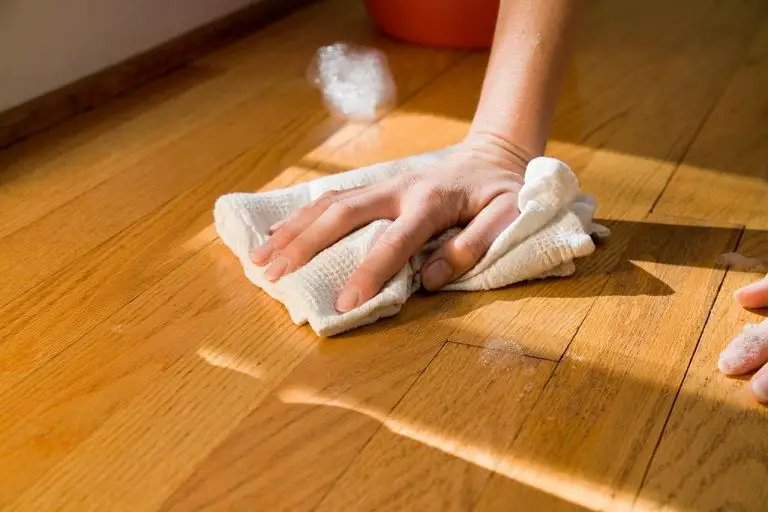Removing dried paint from hardwood floors can seem daunting, but with some patience and the right techniques, it can be done without sanding. There are several methods you can try that use common household items to soften and lift the paint so you can remove it without damaging your beautiful wood floors.
Page Contents
What You’ll Need
Before you start, gather the following supplies:
- Paint remover or stripper – Citrus-based or soy-based removers work well for minimal odor and toxicity
- Plastic putty knife or paint scraper
- Steel wool – Fine grade 00 or 000
- Soft cloths
- Trash bags
- Rubber gloves and eye protection
- Mineral spirits or denatured alcohol
- WD-40 lubricant
- Razor blades
- Clean rags
- Mild cleaner like Murphy Oil Soap
Step 1: Loosen the Paint
The first step is to loosen the dried paint and soften it for removal. You have a few options for DIY paint strippers:
- Vinegar: Mix equal parts warm water and vinegar, sponge it onto the paint, allow it to sit for 15 minutes, then scrape.
- Baking soda: Make a paste with baking soda and water. Apply to paint, allow to sit briefly until dry, then scrape.
- WD-40: Spray directly onto paint and allow to penetrate for 5 minutes before scraping.
- Commercial paint remover: Apply a thick coat according to directions and allow it time to work before scraping.
Step 2: Gently Scrape the Paint
Once the paint is loosened, use your plastic putty knife or paint scraper to gently lift the paint away from the floor. Hold the scraper at a 30 degree angle and slowly scrape to avoid gouging the wood. Apply more remover or lubricant as needed if paint remains stuck on.
For textured areas, use fine steel wool to rub away leftover flecks of paint.
Step 3: Clean the Surface
After all the paint is removed, wipe the floor with a clean rag dampened with mineral spirits to remove any remaining residue. Let it dry completely. Use increasingly finer grits of steel wool to buff out any remaining paint specks or rough areas.
Vacuum the floor thoroughly to remove all dust and debris. Follow up by wiping with a damp rag and Murphy Oil Soap to clean and condition the bare wood.
Tips for Success
- Work in small sections for the easiest removal.
- Keep liquids limited to prevent damage to your floors.
- Rinse often to prevent paint gunk buildup on your tools.
- Apply painter’s tape around trim or walls to protect surfaces.
- If paint remains stuck in cracks or carved details, use a razor blade to gently pry it out.
- Buff with the grain, not against it.
- Be patient – dried paint can be stubborn!
Caution When Using Chemical Paint Strippers
While very effective at removing paint, chemical stripping products contain harsh solvents and should be used with extreme care:
- Work in a well-ventilated area and wear protective equipment.
- Never mix chemical strippers, as toxic fumes can result.
- Avoid skin and eye contact by wearing gloves and safety goggles.
- Follow all label safety directions carefully.
- Dispose of used stripper according to your local household hazardous waste guidelines.
When to Call a Professional
While DIY paint removal is possible for small areas or thin layers of paint, there are times you may want to call in a professional:
- If there are more than 2-3 layers of paint built up
- If paint is covering a very large area, like an entire room
- If you want to refinish the floors with stain or sealant after paint removal
- If paint is stuck deeply into wood grains or carved details
- If you don’t have the time for the lengthy DIY process
Professionals have commercial-grade tools, stripping chemicals, and floor sanders to remove paint quickly and effectively. This also avoids the mess and odors of DIY strippers in your home. Cost will depend on the size of the job.
Preventative Maintenance
An ounce of prevention is worth a pound of cure when it comes to paint and wood floors. Here are some tips to avoid painted wood floors in the first place:
- Use drop cloths or tarps when painting nearby walls and trim.
- Tape down plastic sheeting just outside the room you are painting.
- Seal off doorways with plastic to contain paint drips.
- Use high quality painters tape for the best adhesion without residue.
- Carefully line the edges where wall meets floor with tape.
- Always paint baseboards, trim, and walls before installing new hardwood floors.
Conclusion
Removing dried paint from hardwood can be accomplished without sanding by using common household items to soften paint for easy scraping. With some elbow grease and the proper technique, you can successfully remove paint from your wood floors without damaging them in the process. Be cautious when using chemical strippers and call a professional if you have extensive paint buildup or want to refinish floors after paint removal. And prevention is always best – properly prepare painting areas to avoid spills and splatters on those beautiful hardwood floors in the first place.
